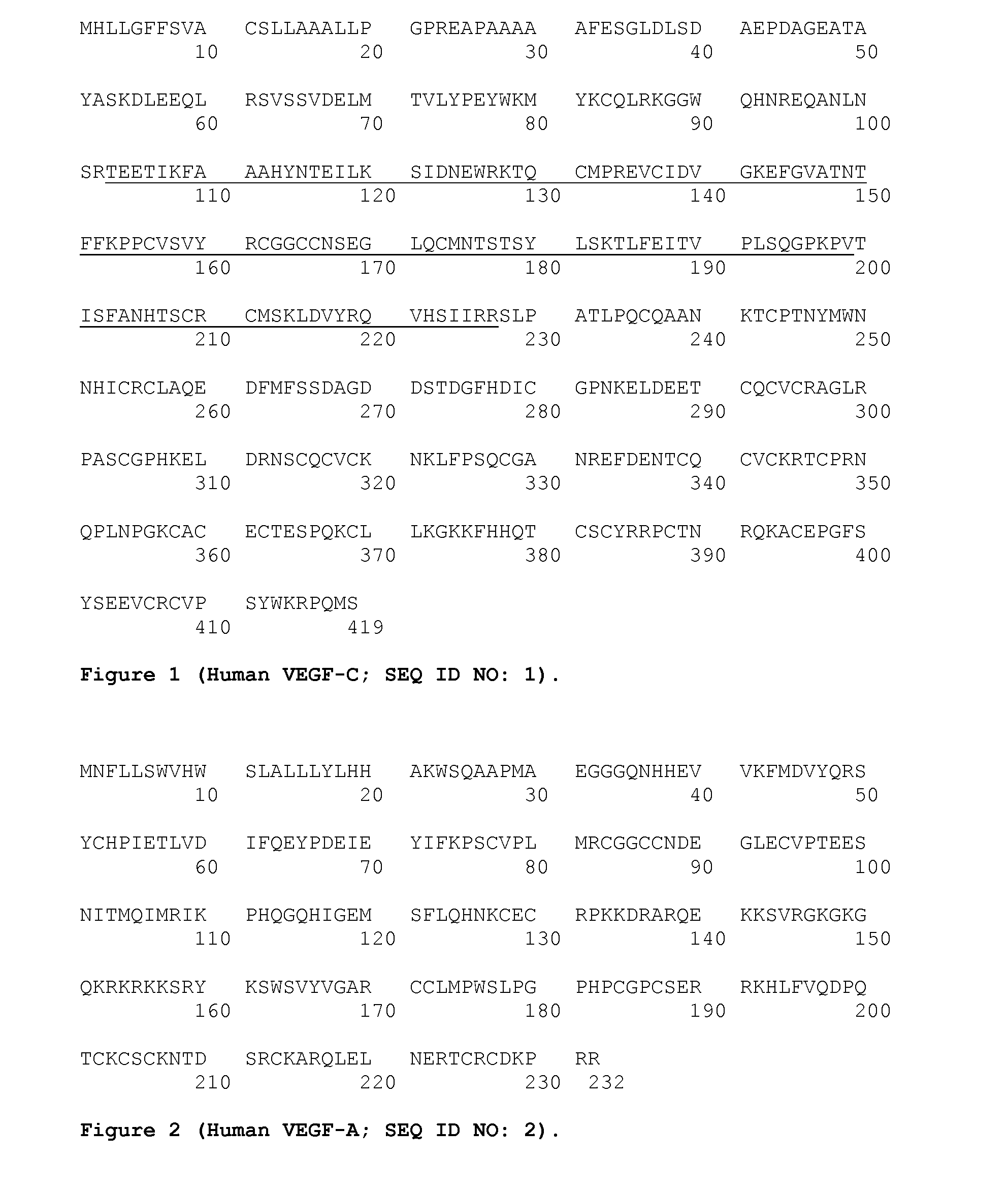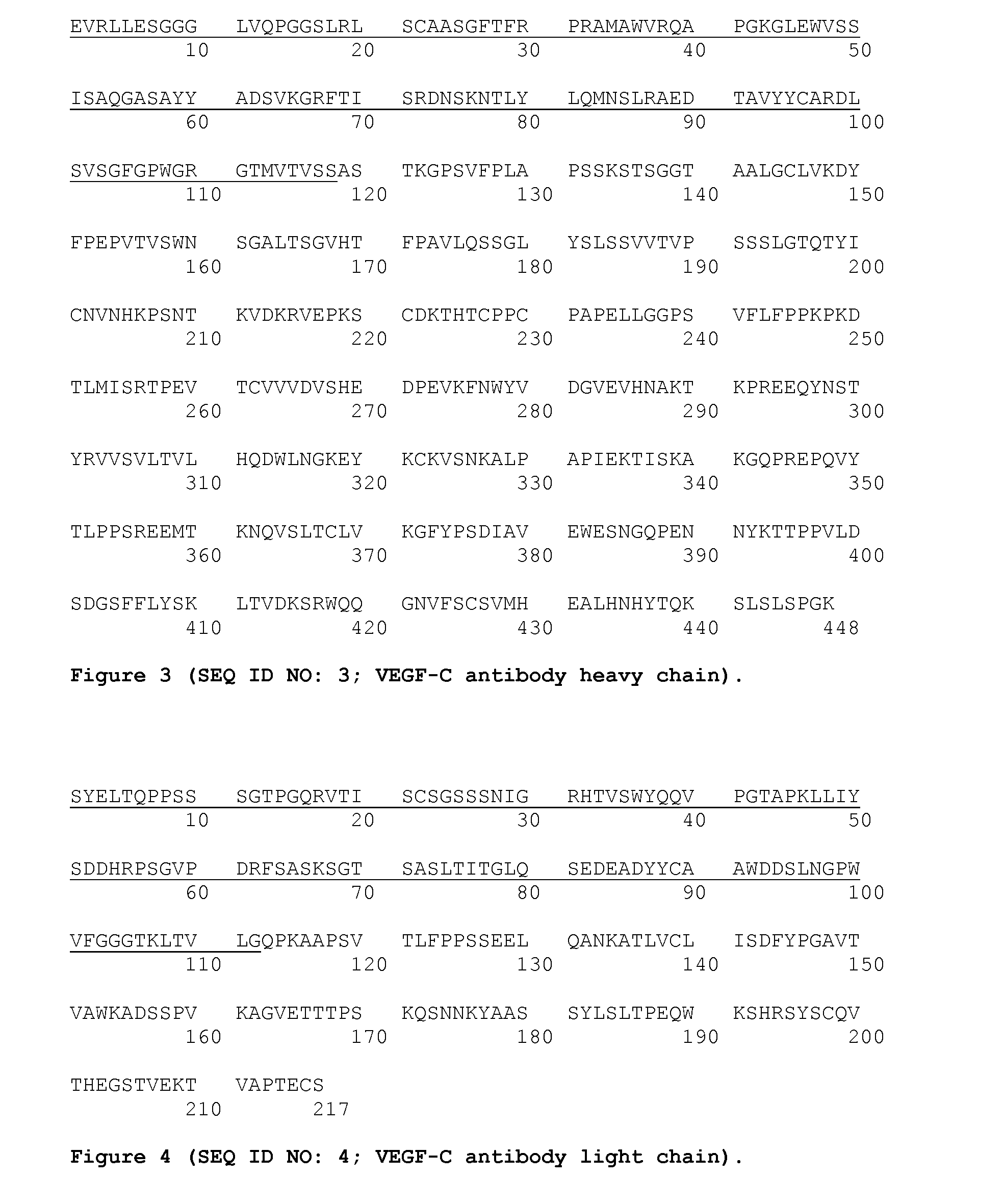Combination treatment with vegf-c antagonists
a technology of vegfc and antagonists, applied in the field of cancer treatment, can solve the problems of inability to detect and treat cancer in time, the current method of cancer treatment is relatively non-selective, and cancer remains one of the most deadly threats to human health, so as to prevent or ameliorate the effect of metastasis
- Summary
- Abstract
- Description
- Claims
- Application Information
AI Technical Summary
Benefits of technology
Problems solved by technology
Method used
Image
Examples
example 1
[0208]VEGF-C antibody VGX-100 was assessed by a direct binding ELISA using VEGF-C, VEGF-D or VEGF (R&D Systems) as capture antigens and bound VGX-100 detected with rabbit anti-human IgG-HRP (Abcam). The results are presented in FIG. 14. VGX-100 selectively recognized and bound to VEGF-C by ELISA with a KD 1.8 nM (BiaCore).
[0209]Bioassays to measure the binding of VEGF-C to the extracellular domain of VEGFR-2 or VEGFR-3 were performed with BA / F3-VEGFR-2 or BA / F3-VEGFR-3 / EpoR cells. The response to ligands and VGX-100 was measured by [3H] thymidine incorporation following exposure for 48 hrs. The results are presented in FIG. 15. VGX-100 blocked VEGF-C binding to (a) VEGFR-2 and (b) VEGFR-3 in Ba / F3 bioassays.
[0210]HUVEC proliferation assays were conducted for 48 hrs and cell number measured with WST-1 reagent (Roche). The results are shown in FIG. 16. VGX-100 inhibited VEGF-C stimulated HUVEC proliferation.
example 2
Prostate Cancer (PC-3) Single Therapy
[0211]To initiate the study, 5×106 PC-3 cells suspended in 100 μl of a mixture of medium / Matrigel (1:1) were subcutaneously implanted to the nude mice in the right flank region. Cells were implanted into 80 mice. Animals were monitored for tumor growth daily after cell implantation. When tumor volumes reached 80-100 mm3, mice were randomized into 5 groups of 10 mice each using only mice having tumor volumes closest to the mean value. Mice with tumor volumes too big or too small were excluded from the study. Tumor volumes were measured using the formula V=L×W×H×τ / 6, where L and W represent the longer and shorter diameters of the tumor and H represents the height of the tumor. The treatment with drugs began on the day after randomization. Vehicle control, test antibody and the VEGF-A antibody bevacizumab were administered by intraperitoneal injection in volumes ranging between 68-108 μl per dose. Bevacizumab was supplied as drug in aqueous solution...
example 3
Combination Therapy in a Prostate Cancer (PC-3) Xenograft Model
[0213]This experiment evaluated the anticancer efficacy of the VEGF-C antibody VGX-100 alone and in combination with the VEGF-A antibody bevacizumab, the chemotherapeutic agent docetaxel, and bevacizumab+docetaxel against established PC-3 human prostate carcinoma xenografts in male nu / nu mice. Specifically, the following treatments were evaluated: (i) VGX-100+bevacizumab; (ii) VGX-100+docetaxel; (iii) VGX-100+docetaxel+bevacizumab; (iv) docetaxel; and (v) docetaxel+bevacizumab. VGX-100 and bevacizumab were administered at 10 mg / kg intraperitonealy every three days for two injections, followed by three days of rest for the duration of the experiment (twice each week, 3 days apart). Docetaxel was administered intravenously at 10 mg / kg weekly for three injections.
[0214]Materials and Methods
[0215]Chemicals
[0216]HIgG1 Isotype control-humanised antibody (6.4-12.36 mg / ml) and VGX-100 (5.53 and 5.75 mg / ml) were provided as froze...
PUM
| Property | Measurement | Unit |
|---|---|---|
| absorbance wavelength | aaaaa | aaaaa |
| pH | aaaaa | aaaaa |
| dissociation constant | aaaaa | aaaaa |
Abstract
Description
Claims
Application Information
 Login to View More
Login to View More - R&D
- Intellectual Property
- Life Sciences
- Materials
- Tech Scout
- Unparalleled Data Quality
- Higher Quality Content
- 60% Fewer Hallucinations
Browse by: Latest US Patents, China's latest patents, Technical Efficacy Thesaurus, Application Domain, Technology Topic, Popular Technical Reports.
© 2025 PatSnap. All rights reserved.Legal|Privacy policy|Modern Slavery Act Transparency Statement|Sitemap|About US| Contact US: help@patsnap.com



